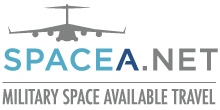The short answer is “Yes” but it’s going to take some detective work and time on your part. First, you probably won’t find any recordings for flight info at these non-military locations. Most of these flights are known as Operational Support Airlift (OSA) and are listed online on the JOSAC web site if you have .mil access and a DoD Common Access Card (not available to retirees).
Here’s the steps you’ll need to take:
1. If you see a flight that interests you then consult www.airnav.com ("Airports" tab using the 4-letter ICAO airport code in the search field). Towards the bottom of that page, you will find a section entitled "FBO, Fuel Providers, and Aircraft Ground Support". FBOs are Fixed Base Operators and they are businesses that handle non-commercial flights (otherwise known as General Aviation (GA) flights). Here's a link to another FBO Locator. Call the FBO's and ask if they handle military flights coming into the airport. Explain to them that you are a member of the military (retired/active or other) and that you are trying to meet up with the plane but that you are unsure which FBO they are coming into. There is usually one FBO at a location that handles the military/government contract on the airport.
2. Once you know which FBO is handling the flight, you will need to make sure you are at the FBO by at least two hours before the flight arrives.
3. Your next hurdle is to find a place to park your car for the duration of your travels.
4. Trek over to the FBO building with your bag (under 30 lb for these small aircraft) and let the FBO staff know you are waiting on a military flight coming in and where it is going to. Ask her/him to alert the crew upon arrival that there is a member of the military in the terminal that would like to speak with them. Also if you see ground personnel walking through the lobby, ask them to alert the flight crew as well. Then get near a window and keep an eye out for a military aircraft. Usually these are going to be small executive transport type planes, so they will somewhat look just like the others out there, with the exception that ours will be marked "U.S. Air Force,NAVY, U.S. Army, etc....
5. Contact the flight crew when they come into the terminal, introduce yourself (Rank, name and branch) and advise them that you would like to catch a ride with them (Space-A). They’ll then let you know if they have room or if there are any other restrictions that prevent you from flying Space-A on that aircraft.
6. It would behoove you to carry a copy of a DD Form 2131 (flight manifest form) with you when flying just in case the flight crew does not have one with them. Technically they can refuse to take you because they don't have a manifest form.


